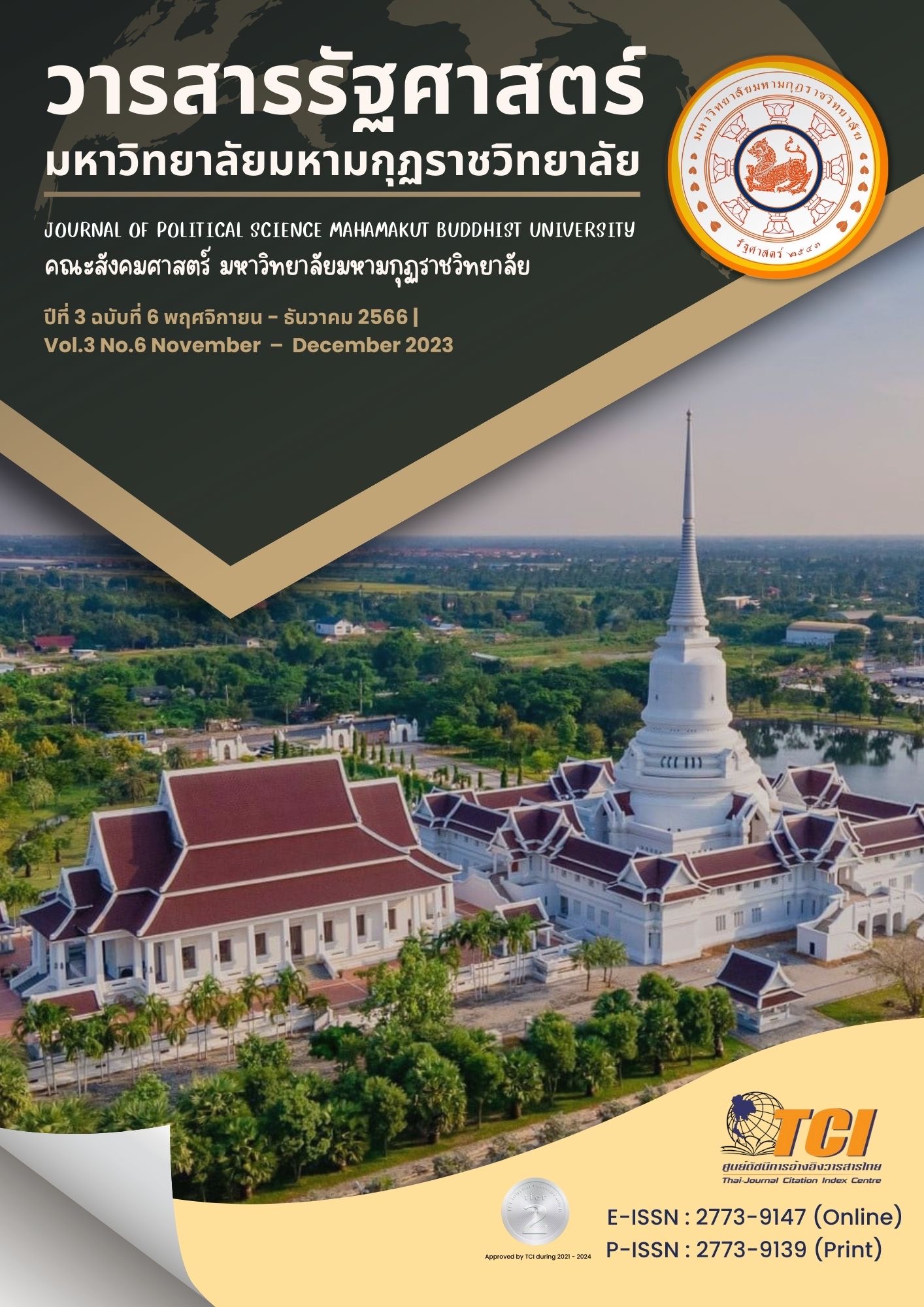DEVELOPING PATTERNS FOR COMMERCIAL SANDALWOOD FLOWER WREATHS THROUGH THE PARTICIPATION OF THE ELDERLY GROUP IN NONG YANG THA KWIAN, WATTHANA NAKHON, SAKAEO PROVINCE
Main Article Content
Abstract
This research aims to achieve several objectives. Firstly, it seeks to comprehensively study the environment and potential of commercial sandalwood flower wreath producers. Secondly, it aims to develop sandalwood flower wreath patterns through the implementation of a participatory process. Finally, it endeavors to survey the satisfaction of product buyers, specifically focusing on their perceptions of the beautiful patterns resulting from the product development process. In order to investigate the research objectives comprehensively, this research adopts a mixed-methods approach to comprehensively investigate the research objectives. Qualitative research is employed, utilizing a participatory method that actively involves a group of 7 members. Additionally, quantitative research is conducted using a questionnaire to assess the satisfaction levels of a purposive random sample of 30 customers, with a specific focus on evaluating aesthetic dimensions. The data collected for this study were subjected to analysis using descriptive statistics, specifically employing measures such as mean and standard deviation.
The findings of the study revealed several key insights. Firstly, in terms of strengths, the leader demonstrated effective management of work, leveraging the abilities of group members. Additionally, the group exhibited equitable income distribution and possessed an efficient transportation and ordering system. However, a notable weakness identified was the group members' limited ability to independently innovate and create new patterns. In relation to opportunities, the study identified that increased promotion and public relations efforts by government agencies could enhance customer awareness and familiarity with the products both within and beyond the sub-district, consequently leading to potential income growth for group members. On the contrary, the group encountered a distinct challenge whereby they shared the viewpoint that the arrangement pattern of sandalwood flowers on the wreaths bore striking resemblance to those adopted by other groups. Secondly, employing a community participation process, the study revealed that the group engaged in collaborative activities such as collectively designing distinctive patterns, collaboratively refining patterns to enhance their aesthetic appeal, and collaboratively assigning names to new patterns, including the Cho Phaka pattern, Rasami Khae pattern, and Sai Natee pattern. Thirdly, based on a survey conducted to gauge buyer satisfaction with the aesthetic dimension of patterns resulting from product development, the study identified the top two satisfaction scores. The first pertained to the aesthetic dimension of novelty, with a mean score of 4.80 and a standard deviation of 0.48. Similarly, the aesthetic dimension of pattern appropriateness garnered a mean score of 4.77 and a standard deviation of 0.50, reflecting the highest level of satisfaction across all items.
Article Details

This work is licensed under a Creative Commons Attribution-NonCommercial-NoDerivatives 4.0 International License.
References
ชมภูนุท จั่นนุ้ย, และพินิจ ลาภธนานนท์. (2562). ความสำเร็จของวิสาหกิจชุมชนบนพื้นฐานความอยู่รอดและพอเพียง. วารสารศิลปศาสตร์ปริทัศน์, 14 (1),67-78
ณัฏฐนันธ สุวรรณวงก์. (2556). กระบวนการพัฒนาศักยภาพชุมชนต่อการส่งเสริมเศรษฐกิจชุมชนและกลุ่มอาชีพ: กรณีศึกษา โครงการสายใยรักแห่งครอบครัวฯ บ้านนาดี-สร้างบง ตำบลผาสุก อำเภอกุมภวาปี จังหวัดอุดรธานี. วารสารวิชาการศรีปทุม. 11(2), 37-44
ดวงพร ไม้ประเสริฐ. (2566). การพัฒนาลวดลายผลิตภัณฑ์ตะกร้าหวายเทียมและบรรจุภัณฑ์ของชุมชนบ้านหลุมข้าว. วารสารวิจัยราชภัฏกรุงเก่า, 10(2), 39-50.
ทวีศักดิ์ สาสงเคราะห์ และคณะ. (2551). การออกแบบและพัฒนารูปแบบบรรจุภัณฑ์ สำหรับผลิตภัณฑ์จากผ้าไหมสุรินทร์. กรุงเทพมหานคร: คณะอุตสาหกรรมสิ่งทอและออกแบบแฟชั่น มหาวิทยาลัยเทคโนโลยีราชมงคลพระนคร.
ปัณณ์ณัช ธนัทพรรษรัตน์, และฉันทนา สุรัสวดี. (2558). การพัฒนารูปแบบผลิตภัณฑ์สินค้าชุมชนโดยใช้วิธีการวิจัยปฏิบัติการแบบมีส่วนร่วม กรณีศึกษา :ผลิตภัณฑ์ของใช้ในครัวเรือนบ้านคลองเดื่อพัฒนา ตำบลท่ามะนาว อำเภอชัยบาดาล จังหวัดลพบุรี. วารสารเพื่อการพัฒนาเชิงพื้นที่, 7(3),76-89
เพลินทิพย์ โกเมศโสภา. (2555). การวางแผนการตลาด. (พิมพ์ครั้งที่ 12). กรุงเทพมหานคร: โรงพิมพ์แห่งจุฬาลงกรณ์มหาวิทยาลัย.
มาลินี คำเครือ,และธีระพันธ์ โชคอุดมชัย. (2562). กลยุทธ์การสื่อสารการตลาดออนไลน์ที่มีผลต่อพฤติกรรมการซื้อสินค้าโอทอปผ่านสื่อสังคมออนไลน์ของผู้บริโภคในจังหวัดกาญจนบุรี. วารสารวิจัยราชภัฏกรุงเก่า, 6(1),1-8
วิภาวดี ผกามาศ. (2566). การเพิ่มขีดความสามารถในการผลิตของกลุ่มดอกไม้จันทน์บ้านโนนสะอาดจังหวัดเพชรบูรณ์. วารสารมนุษศาสตร์และสังคมศาสตร์ มหาวิทยาลัยราชพฤกษ์, 9(1), 341-352.
สมบัติ นามบุรี. (2562). ทฤษฎีการมีส่วนร่วมในงานรัฐประศาสนศาสตร์. วารสารวิจยวิชาการ, 2(1), 183-194
สำนักงานคณะกรรมการพัฒนาการเศรษฐกิจและสังคมแห่งชาติ. (2560). สรุปสาระสำคัญของยุทธศาสตร์ชาติ 20 ปี (ปีพ.ศ.2561 –2580). เรียกใช้เมื่อ 10 ตุลาคม 2566 จาก https://www.nesdc.go.th/download/document/SAC/NS_SumPlanOct2018.pdf
อัปสรอีซอ จิราพร เกียรตินฤมล และอุษณีย์ พรหมศรียา. (2566). การพัฒนาช่องทางการจัดจำหน่ายและการสร้างแบรนด์กระเป๋า “Duri” ของวิสาหกิจชุมชนกลุ่มแม่บ้านเกษตรกรสันติภาพวังพญา อำเภอรามัน จังหวัดยะลา. วารสารวิจัยราชภัฏกรุงเก่า, 10(1), 115-121.
อุกฤษฏ์ ชาวแพรกน้อย. (2564). การมีส่วนร่วมของผู้สูงอายุต่อกิจกรรมการพัฒนาคุณภาพชีวิตของเทศบาลตำบลหลักห้า อำเภอบ้านแพ้ว จังหวัดสมุทรสาคร. วารสารบัณฑิตศึกษา, 80 (18), 15-21.


